In Croatia and with Family in Italy
I flew on Iberia Airlines over the Atlantic to Rome via Madrid. Once
again, the actual traveling part of traveling was quite
exhausting. The Madrid to Rome leg was a full business commuter flight
where everything to eat or drink cost money, even water. On the other
hand they gave away free papers like the Financial Times. I had
already booked round trip flights to Rome (months in advance) when I
decided to take advantage of the opportunity to visit my friend
Michael in Dubrovnik, Croatia. He had come to the reunion of The Land
community in June and when we talked had graciously invited me to
visit him in Europe. 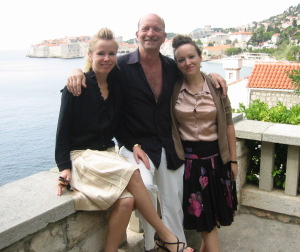 As Croatia is just a hop across the Adriatic from
Italy I booked a round trip flight from Rome to Dubrovnik not
realizing what a pain it would turn out to be. The flights were on
Croatia Airlines and, while the ticket claimed one stop, there were
actually two stops. First on entering Croatia (and last on leaving it)
the flight went through Split, in what was called a technical stop,
for Croation customs; then Zagreb, then Dubrovnik. At each stop we had to exit
the airplane and go back through security. On the way back it was
even worse as their computers were down so we not only had to get
re-screened by security each time, but also had to pick up and recheck
our bags.
As Croatia is just a hop across the Adriatic from
Italy I booked a round trip flight from Rome to Dubrovnik not
realizing what a pain it would turn out to be. The flights were on
Croatia Airlines and, while the ticket claimed one stop, there were
actually two stops. First on entering Croatia (and last on leaving it)
the flight went through Split, in what was called a technical stop,
for Croation customs; then Zagreb, then Dubrovnik. At each stop we had to exit
the airplane and go back through security. On the way back it was
even worse as their computers were down so we not only had to get
re-screened by security each time, but also had to pick up and recheck
our bags.
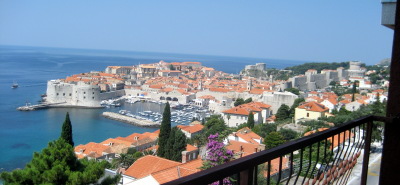 The Croatian airports were charmingly small, straight out of the
1950s; boarding via stairs out on the tarmac. The security personnel
all wore very plain, light green Eastern European uniforms. The men
all had crew cuts. Men and women alike tended to be stern looking
blonds. Everything seemed spare, sparse and humorless. Funny thing
though, at one of these never-ending security screenings the alarms
went off when I went through the gateway. ``Oh!'' I said, ``I forgot
to take these coins out of my pocket,'' pulling coins out of my pocket
and showing the guard. ``OK, go ahead,'' said the guard and waved me
along without rechecking me. On the flights they served a
small traditional Croation pastry, the Pap Rentak, and offered to sell
me cartons of cigarettes.
The Croatian airports were charmingly small, straight out of the
1950s; boarding via stairs out on the tarmac. The security personnel
all wore very plain, light green Eastern European uniforms. The men
all had crew cuts. Men and women alike tended to be stern looking
blonds. Everything seemed spare, sparse and humorless. Funny thing
though, at one of these never-ending security screenings the alarms
went off when I went through the gateway. ``Oh!'' I said, ``I forgot
to take these coins out of my pocket,'' pulling coins out of my pocket
and showing the guard. ``OK, go ahead,'' said the guard and waved me
along without rechecking me. On the flights they served a
small traditional Croation pastry, the Pap Rentak, and offered to sell
me cartons of cigarettes.
Michael was kind enough to meet me at the airport. As we were waiting
for my luggage he asked, ``So, what brings you to Dubrovnik?'' ``I
have a friend here,'' I replied. ``Who's that, then?'' he said. I
looked him up and down for few seconds with a quizzical look and then
he realized I was talking about him and gave a laugh.
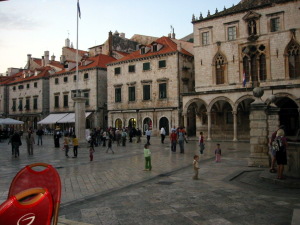 He had a very nice apartment with a grand view of the old walled city.
His fiance Kati and her sister Ewa had also come in from Berlin with
him. Lots of talk, talk, talk which I enjoyed very much. There is an
island just off the coast that can be plainly seen from Michael's
window. One morning I watched a huge cruise ship maneuver into
position, blocking a surprising amount of the view, and then
send wave after wave of boats full of tourists to the docks by the old
city. There must have been thousands of the tourists.
He had a very nice apartment with a grand view of the old walled city.
His fiance Kati and her sister Ewa had also come in from Berlin with
him. Lots of talk, talk, talk which I enjoyed very much. There is an
island just off the coast that can be plainly seen from Michael's
window. One morning I watched a huge cruise ship maneuver into
position, blocking a surprising amount of the view, and then
send wave after wave of boats full of tourists to the docks by the old
city. There must have been thousands of the tourists.
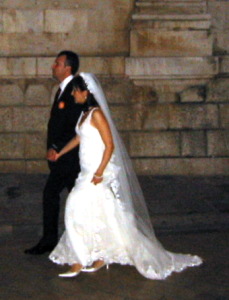 That day we spent a lot of time in the old walled city, seeing the
sights and enjoying the feel of it. We ate outside at a friendly
restaurant off a winding stone stairway, and enjoyed fresh fish (which
the waitress carved into a dog's breakfast) and watched the tourists
stumble by. At dusk, after the tourists had gone back to their cruise
ship, we sat in Dubrovnik's nice main square and drank coffee while
families strolled by. A wedding party burst upon the scene loud and
laughing. The bride looked so happy.
That day we spent a lot of time in the old walled city, seeing the
sights and enjoying the feel of it. We ate outside at a friendly
restaurant off a winding stone stairway, and enjoyed fresh fish (which
the waitress carved into a dog's breakfast) and watched the tourists
stumble by. At dusk, after the tourists had gone back to their cruise
ship, we sat in Dubrovnik's nice main square and drank coffee while
families strolled by. A wedding party burst upon the scene loud and
laughing. The bride looked so happy.
On Saturday we went north to a marina where Michael kept his boat.
The plan was to visit an island or two and enjoy a day on the Adriatic.
Unfortunately, someone had used the boat in Michael's absence and
brought it back with no gas. Michael was pretty upset because the
only extra keys were at the marina office which meant that the marina staff had to be
in on it. But, being the weekend in Croatia meant that the marina office
was closed and so was the gas station! So no complaining to the
authorities and no boating without gas. Instead we toured the coast a
bit by car after breakfast in the marina restaurant.
We visited a villa that Michael was negotiating to buy. It was a
centuries-old convent and one of the first places built outside the
city walls. It had much potential and Michael and Kati were full of
plans for renovating it. One of Michael's dreams is to establish a
Dubrovnik Shakespeare Festival and the villa will partially be used as
home for this.
On to Italy
``Rome reminds me of a man who lives by exhibiting to travellers his
grandmother's corpse.''
James Joyce
On Sunday I bid farewell and took my circuitous journey back to Rome,
arriving late in the afternoon. 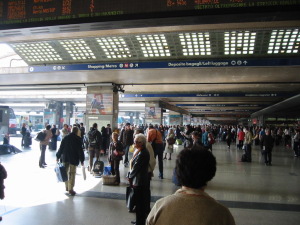 I took the train from the airport into Rome. I had read in the guidebooks that one should time-stamp one's train ticket at one of the machines on the platform. The guidebooks said that technically there was a fine for not doing so but it had never been known to be imposed on a tourist. In the compartment where I settled was an American family from South Carolina just arriving in Europe. I got to talking with the father and found out it was their first trip overseas. As the conductor made his way down the aisle towards us I showed him my ticket with the time-stamp upon it and asked if he had stamped his. This was all news to him. "Oh no," I said, shaking my head, "That's a hundred euro fine!" He began to panic at the thought that he'd made this mistake and that it was going to cost him. As the conductor got closer he began to ask others hurried questions, but received only Italian or broken English answers. When the conductor arrived he began explaining rapidly that he hadn't known about having to stamp his tickets, and began apologizing. The conductor looked at him like he was crazy and waved him off, punched his tickets and continued on down the aisle. He looked over at me to find me laughing. "You," he said, "are a very bad man."
I took the train from the airport into Rome. I had read in the guidebooks that one should time-stamp one's train ticket at one of the machines on the platform. The guidebooks said that technically there was a fine for not doing so but it had never been known to be imposed on a tourist. In the compartment where I settled was an American family from South Carolina just arriving in Europe. I got to talking with the father and found out it was their first trip overseas. As the conductor made his way down the aisle towards us I showed him my ticket with the time-stamp upon it and asked if he had stamped his. This was all news to him. "Oh no," I said, shaking my head, "That's a hundred euro fine!" He began to panic at the thought that he'd made this mistake and that it was going to cost him. As the conductor got closer he began to ask others hurried questions, but received only Italian or broken English answers. When the conductor arrived he began explaining rapidly that he hadn't known about having to stamp his tickets, and began apologizing. The conductor looked at him like he was crazy and waved him off, punched his tickets and continued on down the aisle. He looked over at me to find me laughing. "You," he said, "are a very bad man."
As I walked out of the train station,
trying to get my bearings, a young Italian walked up to me and asked
if I needed a cab. I looked over at the curb where there were a long
line of people apparently waiting for taxis and said, ``Don't I have to go over
there?''
``Oh no,'' he said, ``I've got my own cab. Where do you want go go?''
``The Mimosa Hotel,'' I said and showed him my copy of
the emailed confirmation which had the address on it.
``No problem, 25 euros complete,'' he said.
 Alright, so off we went. The Mimosa hotel was located on Via di Santa
Chiara a few blocks from the Pantheon. My cabbie didn't know where it
was, of course, but he did drop me off on the right street, if a few blocks away at another
hotel. At least he got me to the street. Comparing notes with my
brother later, he had the same thing happen to him at the airport
except he was taken for even more euros. Experience taught us that taxis in
Rome are extraordinarily reasonable and a cab ride from the train station to
the hotel should have cost us less than 10 euros. Ah, live and learn.
And his taxi driver didn't even take him to the street but dropped him
off at Corseo Vittorio Emanuelle, the large boulevard some blocks
away.
Alright, so off we went. The Mimosa hotel was located on Via di Santa
Chiara a few blocks from the Pantheon. My cabbie didn't know where it
was, of course, but he did drop me off on the right street, if a few blocks away at another
hotel. At least he got me to the street. Comparing notes with my
brother later, he had the same thing happen to him at the airport
except he was taken for even more euros. Experience taught us that taxis in
Rome are extraordinarily reasonable and a cab ride from the train station to
the hotel should have cost us less than 10 euros. Ah, live and learn.
And his taxi driver didn't even take him to the street but dropped him
off at Corseo Vittorio Emanuelle, the large boulevard some blocks
away.
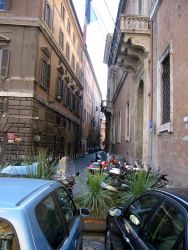 At the wrong hotel, where I was dropped off, I wandered up and down
the street for a few minutes and then entered the lobby and---trying
out my smattering of Italian---asked where the Hotel Mimosa was. The
hotel clerk took me outside and, while pointing up the street,
unleashed a stream of incomprehensible Italian. I had to confess, in
my memorized Italian phrases, that I didn't speak Italian very well.
``English?'' he asked and then told me where the hotel was.
At the wrong hotel, where I was dropped off, I wandered up and down
the street for a few minutes and then entered the lobby and---trying
out my smattering of Italian---asked where the Hotel Mimosa was. The
hotel clerk took me outside and, while pointing up the street,
unleashed a stream of incomprehensible Italian. I had to confess, in
my memorized Italian phrases, that I didn't speak Italian very well.
``English?'' he asked and then told me where the hotel was.
I wandered by it the first time and at the end of the via was a booth
staffed by a uniformed Italian police officer. These are dotted all
over Rome. Using the same phrases that got me help from the hotel
staff I asked where the hotel Mimosa was. He looked up from his
reading, peered at me over his glasses, and looked at me like I was
from another planet. I made a second try, but after he just continued
to look me up and down saying nothing, I left and wandered back down
the via where this time I found the door with the hotel's plaque,
pushed the intercom and was buzzed in after explaining I was a
guest.
The hotel was 57 steps up to the third floor, no lift, so up I trudged
where the gentleman at reception signed me in and showed me down the
halls to the room my brother Paul had already checked into. A note
waited for me saying he had gone to our see our sister and brother-in-law, Mary and Don, at their hotel and would be back soon. And sure enough, very
quickly my brother Paul along with my brother-in-law Don showed up.
We decided to walk back over to see Mary at her hotel. This was a
route my brother Paul and I would come to know well. This first time
was a great savoring experience. First we stopped at Piazza della
Rotunda and admired the Pantheon. The square was very crowded. My
brother asked if I had eaten and I said no but I'd love to. Rome has
all these lovely outdoor cafes in their piazzas, with many tables and
umbrellas. He and Don had both eaten but we asked at a crowded
ristaurante about getting a table, explaining that only I was eating
and the waiter shook his head no. I explained I eat a lot though, and
then his face lit up, ``Oh, I forgot about the little table,'' he
exclaimed. And led us over to a small table at the very edge on the
piazzo.
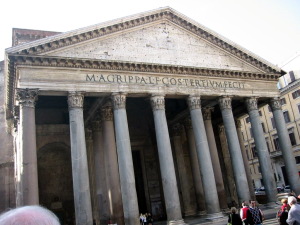 After we ordered, the waiter said, ``And some bruschetti.'' No, I
said, we don't want any. But he brought it anyway and it was the best
bruschetti I have ever had. Delicious. Ever since then I've been
trying bruschetti to find any as good. No luck yet. Don ordered only
a drink, a Dram Bowie on the rocks. The waiter said, ``Don't you want
a man's drink, instead?'' Don declined.
After we ordered, the waiter said, ``And some bruschetti.'' No, I
said, we don't want any. But he brought it anyway and it was the best
bruschetti I have ever had. Delicious. Ever since then I've been
trying bruschetti to find any as good. No luck yet. Don ordered only
a drink, a Dram Bowie on the rocks. The waiter said, ``Don't you want
a man's drink, instead?'' Don declined.
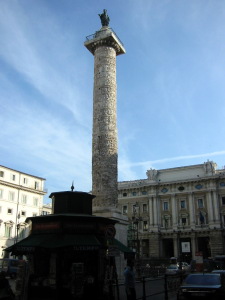 The Pantheon itself sits erect, brooding over the piazza. I found
it's interior uninspiring, but its simple exterior was quite
effective. From the Pantheon we walked by the house of parliament
building (where there was a changing scene every time, including protestors and TV cameras from time to
time) and by the column of Marcus Aurelius to the Trevi Fountain. This was the
first time I saw the famous fountain, which was lit up beautifully with crowds of people
around and vendors working them. The water sounded soothingly and the
crowd was happily chattering away. I threw a coin in the fountain in
the modern ritual making a wish to visit again with my true love.
The Pantheon itself sits erect, brooding over the piazza. I found
it's interior uninspiring, but its simple exterior was quite
effective. From the Pantheon we walked by the house of parliament
building (where there was a changing scene every time, including protestors and TV cameras from time to
time) and by the column of Marcus Aurelius to the Trevi Fountain. This was the
first time I saw the famous fountain, which was lit up beautifully with crowds of people
around and vendors working them. The water sounded soothingly and the
crowd was happily chattering away. I threw a coin in the fountain in
the modern ritual making a wish to visit again with my true love.
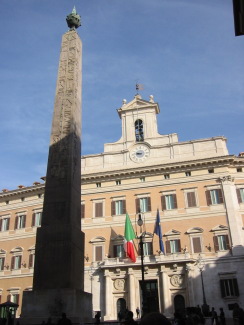
From Trevi fountain it was out to Via del Tritone and up the via to
Piazza Barbarini, which contains Bernini's wonderful Fountain of the
Triton. From there it was a short block to the King Hotel where Mary and
Don were staying. Paul and I were in a one-star, this was a
three-star and much more comfortable than our digs. And it turned out to be not
that much more money. While the Mimosa had a great location, that was
all it had. My bed was short, narrow, lumpy and uncomfortable. The
window opened out onto a noisy alley and the blinds were broken so
that street lights poured in all night. On reflection, I don't think the
savings were worth the misery.
After visiting my sister, we retraced our steps home to our
uncomfortable, but well situated hotel.
Next day, we wandered a bit in the morning, going over to the Piazza
Navone, quite a nice square (oval, actually which the ancients would flood and hold boat races in) with lots of interesting architecture and
fountains and much going on. Every time I came to it, which was
often, it came as a surprise. That morning we sat at an outdoor cafe.
The waiter brought us menus, but we said just coffee: a cappuccino for
Paul, double espresso for me. Sitting in the sun on the piazza,
sipping coffee and people watching was great. With the bill though
came the shock---12.5 euros for coffee? After that we always looked
at the prices in the menus before we ordered. And, of course, we
learned about all the coffee bars where excellent coffee could be had
for a euro or two. To the south of the Piazza is the Pasquino, one of
Rome's ``talking statues'' where you can post comments, witticisms,
etc. When we were there it was covered in papers as there was a heated
election going on.
I asked around for a laundromat as I had been on the road a week now
and needed to wash my clothes. Paul stayed at the hotel for a snooze
while I found a laundry near the Piazza Navone. The Roman running the
laundromat was most amusing. He held court there, crowing and
gesturing and talking to everyone passing by, paying particular
attention to the women. He told me that to be Roman was something very
different and very superior to just being Italian. He taught me some
useful Italian phrases like, ``You have a beautiful ass,'' and ``How
about it?'' etc.
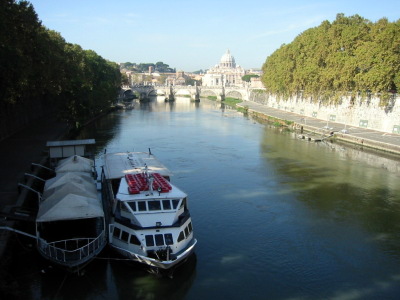 Next day we joined up with Mary and Don (taking our usual
Pantheon-Parliament-Aurelius-Trevi route) for some sightseeing. Mary
is not the most mobile tourist and so we took a few bus tours. At St.
Paul's I stopped to give a gypsy with child a few coins. I asked how
she was doing (in Italian) and she responded, ``Mal.'' ``Bad?'' I
said, ``how can that be, the sun is out and you have a beautiful
baby.'' They may have been renting the children, but it became such a
habit for me that Paul made me turn around in Sorrento once telling me
I had passed a begging mother and child without giving them anything.
One nursing mother even pursued me through the train station wanting more.
Next day we joined up with Mary and Don (taking our usual
Pantheon-Parliament-Aurelius-Trevi route) for some sightseeing. Mary
is not the most mobile tourist and so we took a few bus tours. At St.
Paul's I stopped to give a gypsy with child a few coins. I asked how
she was doing (in Italian) and she responded, ``Mal.'' ``Bad?'' I
said, ``how can that be, the sun is out and you have a beautiful
baby.'' They may have been renting the children, but it became such a
habit for me that Paul made me turn around in Sorrento once telling me
I had passed a begging mother and child without giving them anything.
One nursing mother even pursued me through the train station wanting more.
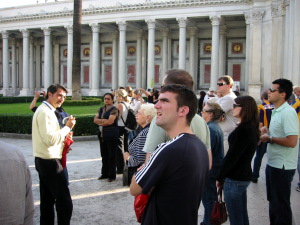
One bus tour picked us up at Mary's hotel and took us around some sites
and then dropped us at a nice travatoria for lunch before resuming the tour. The lunch
was fun and very good. I had learned a smattering of Italian and
always tried to speak it when I could.
It's funny, some waiters seemed to only want to speak English and
seemed bored with the tourists. Others, the best ones, like here,
would play a bit with me in their language. And I really love Italian
expressiveness, talking as much with the hands and the inflections as
the words. The food I tasted in Italy was, with only a few notable
exceptions, fantastic.
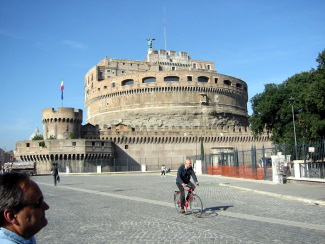 At one point, much to Mary's chagrin, our tour bus broke down outside
the Piazza Navone and we walked by foot over the Tiber across the
Ponte Sant'Angelo with its Bernini angels, past the looming papal
fortress, the Castel Sant' Angelo, and into the Vatican. We walked
past a long row of vendors selling souvenirs, trinkets, jewelry,
books, clothes, etc. The Vatican itself is as ostentatious as
advertised. As a fallen away Catholic I'm sure I'm prejudiced, but I
found St. Peter's to be much too big and many artworks there, notably The
Pieta, were too far away to enjoy. The Vatican museums were quite an
exhibition of treasures (``gallery upon gallery''), but I couldn't
help thinking about the poor. For example, there were room after room
of ornate gilded cabinets whose sole purpose was to hold the gifts
given to the popes over the centuries. We made a tourist mistake of
falling for a pitch and engaging a guide for a few euros. I suppose
it's because we are soft hearted. He was a sweet old man, dressed in
faux professor garb, but his exposition consisted of things he'd
learned by rote that could be found in any ordinary guidebook. (He
also made the unforgivable error of recommending to us a restaurant
run by a friend of his which turned out to serve terrible Americanized
food [beef and potatoes] and vinegary wine.) The Sistene Chapel was
quite charming, however, and well worth the time spent there. I was
glad to see the Delphic Sybil among the ceiling's images.
At one point, much to Mary's chagrin, our tour bus broke down outside
the Piazza Navone and we walked by foot over the Tiber across the
Ponte Sant'Angelo with its Bernini angels, past the looming papal
fortress, the Castel Sant' Angelo, and into the Vatican. We walked
past a long row of vendors selling souvenirs, trinkets, jewelry,
books, clothes, etc. The Vatican itself is as ostentatious as
advertised. As a fallen away Catholic I'm sure I'm prejudiced, but I
found St. Peter's to be much too big and many artworks there, notably The
Pieta, were too far away to enjoy. The Vatican museums were quite an
exhibition of treasures (``gallery upon gallery''), but I couldn't
help thinking about the poor. For example, there were room after room
of ornate gilded cabinets whose sole purpose was to hold the gifts
given to the popes over the centuries. We made a tourist mistake of
falling for a pitch and engaging a guide for a few euros. I suppose
it's because we are soft hearted. He was a sweet old man, dressed in
faux professor garb, but his exposition consisted of things he'd
learned by rote that could be found in any ordinary guidebook. (He
also made the unforgivable error of recommending to us a restaurant
run by a friend of his which turned out to serve terrible Americanized
food [beef and potatoes] and vinegary wine.) The Sistene Chapel was
quite charming, however, and well worth the time spent there. I was
glad to see the Delphic Sybil among the ceiling's images.
From our hotel near the Pantheon Paul and I took a number of walks
through the city. Here are a few of them:
Crossing the Piazza Venezia, Rome's principal hub of traffic, on foot
was great fun and really gave me a feeling of fluidity as I paced
myself and threaded my way through the small cars, trucks and scooters
and they threaded their way around me. We walked past the looming
Victor Emanuel Monument and ended up on the Capitoline Hill which has
Michelangelo's beautiful and serene facades. In the center of the
square is the ancient equestrian statue of Marcus Aurelius. Well,
there is a copy of it, you can see the original in the museum.
The museums occupy the two side palazzi and are connected by a
tunnel. They contain thousands of works of classical antiquity.
Rooms full of them and hallways crowded. Such a wealth of riches.
Almost any one of them, if loaned to the Met or British Museum, would
have its own room and docent. Take for example, {\it The Dying
Gladiator}. I had read Byron's account of it (in the fourth canto of Childe Harold's Pilgrimage:
| I see before me the gladiator lie:
He leans upon his hand -- his manly brow
Consents to his death, but conquers agony,
And his drooped head sinks low, --
And through his side the last drops, ebbing slow
From the red gash, fall heavy one by one,
Like the first of a thunder shower; and now
The arena swims around him -- he is gone,
Ere ceased the human shout which hailed the wretch who won.
|
Well, we found it in the hallway of the second floor of the Capitoline
Museum just in with a jumble of other ancient works.
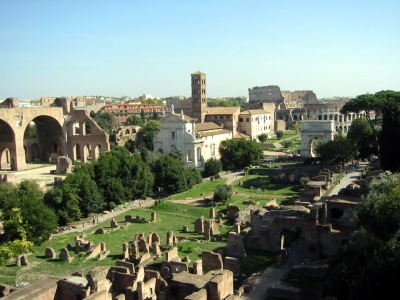 From the Capitoline hill we went exploring the Forum. The Senate
House was much more modest than I expected, a long rectangular
building with several low tiers on each side. Truth is, I found it
hard to make sense of all the bits and pieces of ruin that were
sticking up here and there in the Forum.
From the Capitoline hill we went exploring the Forum. The Senate
House was much more modest than I expected, a long rectangular
building with several low tiers on each side. Truth is, I found it
hard to make sense of all the bits and pieces of ruin that were
sticking up here and there in the Forum. 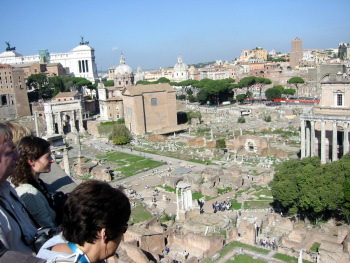 I took their audio tour, but
remember almost nothing. From the Forum we went up the Palantine hill
and had a look at the high-rent district of ancient Rome, that is, the
imperial housing. There was a partially restored villa that was
interesting to see, but what I remember most was the greenery, the
gardens, the light breeze, the dappled sun. It all seemed very
pleasant.
I took their audio tour, but
remember almost nothing. From the Forum we went up the Palantine hill
and had a look at the high-rent district of ancient Rome, that is, the
imperial housing. There was a partially restored villa that was
interesting to see, but what I remember most was the greenery, the
gardens, the light breeze, the dappled sun. It all seemed very
pleasant.
We walked over to the Coliseum which is a magnificent wreck. It's so desolate and ruined that
it cries out something. What, I can't say, but it's definitely
crying. I felt almost meditative touring within it, even with the
noisy crowds.
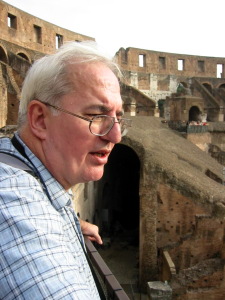
After, we looked for the "golden palace" of Tiberius which is located
near the Coliseum. He had built this obscenely huge and ornate palace
for himself which was allowed to go to ruin the moment he died. We
walked through one inviting gate, up some steps, and along a walk only
to find ourselves in a park populated by numerous sallow young men,
clustering together, casting dark glances at us and everything else.
Ah, it turned out that we'd found the drug dealers. 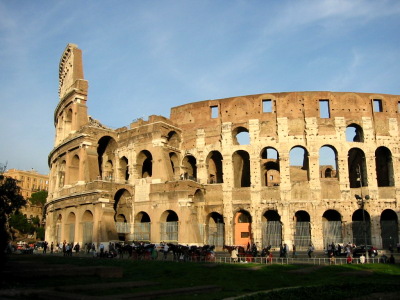 We walked through
the park and asked directions from a bus driver. The driver spoke only
Italian and I failed to make a meaningful connection. He had an
interesting zig-zag kind of hand motion though and undoubtedly that's
the way we should have gone. We didn't though, walking back through
the park to Via Nicola Salvi and the up a very inviting drive called
Via Della Domus Aurea. This turned out to be a family park with
benches along the drive and a small piazza with the ever present Roman
fountain at the end. In the park was a great family scene, from the
oldest grandparents walking with canes and assistance to the youngest
babies. The boys were chasing each other with sticks and the
girls were playing hopscotch on chalked outlines. As we sat on a bench
and rested I received a disapproving look from a Roman matron, as if
we tourists were invading their private space.
We walked through
the park and asked directions from a bus driver. The driver spoke only
Italian and I failed to make a meaningful connection. He had an
interesting zig-zag kind of hand motion though and undoubtedly that's
the way we should have gone. We didn't though, walking back through
the park to Via Nicola Salvi and the up a very inviting drive called
Via Della Domus Aurea. This turned out to be a family park with
benches along the drive and a small piazza with the ever present Roman
fountain at the end. In the park was a great family scene, from the
oldest grandparents walking with canes and assistance to the youngest
babies. The boys were chasing each other with sticks and the
girls were playing hopscotch on chalked outlines. As we sat on a bench
and rested I received a disapproving look from a Roman matron, as if
we tourists were invading their private space.
One day we wandered into the Jewish Ghetto. We went through the busy,
crowded Largo Argentina, pausing to be entertained by a street beggar
who was singing exuberantly and carrying a sign that translated as,
``I'm poor but I'm happy,'' then taking a look at the sunken
excavation of four republican temples. Uncovered only in the twentieth
century, Mussolini stopped new construction from destroying them. The
day we were there, and probably every day, they were a refuge for
cats. Heading south on the Via Arenula we found a neglected, unsigned
park we immediately dubbed ``Pigeon Park'' because of the large amount
of bird droppings covering every inch of it's benches. Winding our
way to the left, we backtracked a bit until we found the Piazza Mattei
with it's famous and lovely tortoise fountain, although it was looking
a bit green. 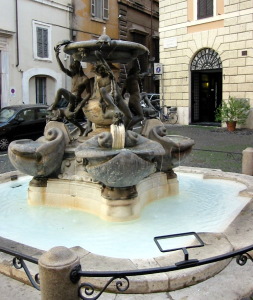 From here it was a short walk to the heart of the Ghetto
with its many shops and curiosities. I thought it would be pleasant
to have a bookshop there. At the end of the main street are the remains
of the huge portico built by Augustus for his sister Octavia. Most of
it is long gone and what remains has some unattractive medieval
construction. For centuries it was the main fish market in Rome.
From here it was a short walk to the heart of the Ghetto
with its many shops and curiosities. I thought it would be pleasant
to have a bookshop there. At the end of the main street are the remains
of the huge portico built by Augustus for his sister Octavia. Most of
it is long gone and what remains has some unattractive medieval
construction. For centuries it was the main fish market in Rome.
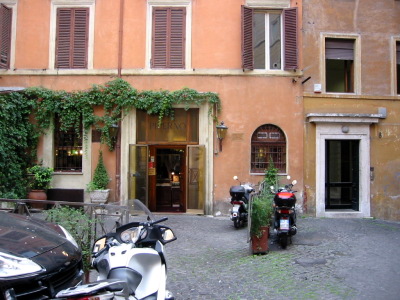 We were looking to enjoy a repast at Piperno's, one of the oldest
restaurants in Rome. It had been known as Father Abrahams or more
commonly, Pappa Abrams. Its specialty was Jewish artichokes. It was
in a small piazza fed by a one-way alley with another leading
away. The food was very good, and the waiters better. Jewish
artichokes are roasted and so have some charring at their edges. Paul
had left some of the outer leaves but the waiter told him to eat them
up, that they were good for him. I'm not the neatest of eaters and
after one course had left crumbs on the table. The waiter
solemnly and meticulously scraped these crumbs off the table with a
stiff card. It was all my brother and I could do to not laugh out
loud.
We were looking to enjoy a repast at Piperno's, one of the oldest
restaurants in Rome. It had been known as Father Abrahams or more
commonly, Pappa Abrams. Its specialty was Jewish artichokes. It was
in a small piazza fed by a one-way alley with another leading
away. The food was very good, and the waiters better. Jewish
artichokes are roasted and so have some charring at their edges. Paul
had left some of the outer leaves but the waiter told him to eat them
up, that they were good for him. I'm not the neatest of eaters and
after one course had left crumbs on the table. The waiter
solemnly and meticulously scraped these crumbs off the table with a
stiff card. It was all my brother and I could do to not laugh out
loud. 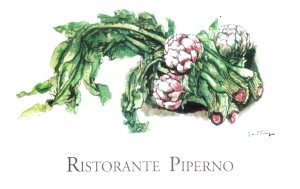 It was such fun that we brought my sister and brother-in-law by
for dinner one night. That night our taxicab driver started cursing
as he could not figure out how to maneuver through the alleys to
deliver us to the front door and had to let us off at the wrong end of a
one way alley and let us walk.
It was such fun that we brought my sister and brother-in-law by
for dinner one night. That night our taxicab driver started cursing
as he could not figure out how to maneuver through the alleys to
deliver us to the front door and had to let us off at the wrong end of a
one way alley and let us walk.
From Piperno's we walked under the shadow of the Synagogue to the
Forum Boarium (cattle market) and admired its two 2nd Century BC
temples: one round, one rectangular. 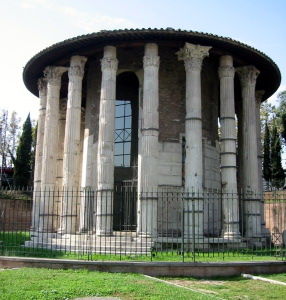 We had to pay a visit of course to
the nearby medieval church of S. Maria in Cosmedin where lives the Boca della
Verite (The Mouth of Truth) which figured so in the film Roman Holiday. And then we went in search of another mouth and ventured out
on the Ponte Palatino to get a view of the Cloaca Maxima, the mouth of
Rome's ancient sewer, where the waste of the ancient rich had emptied into the
Tiber.
We had to pay a visit of course to
the nearby medieval church of S. Maria in Cosmedin where lives the Boca della
Verite (The Mouth of Truth) which figured so in the film Roman Holiday. And then we went in search of another mouth and ventured out
on the Ponte Palatino to get a view of the Cloaca Maxima, the mouth of
Rome's ancient sewer, where the waste of the ancient rich had emptied into the
Tiber.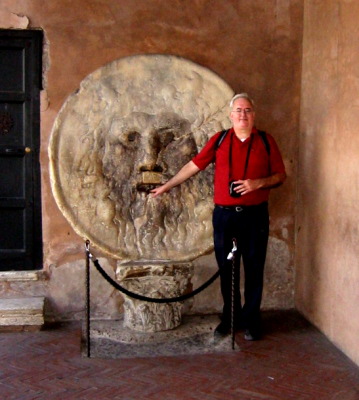
We ventured into the Circus Maximus, a big serviceable grassy oval,
where they were setting up for a political rally with sound trucks and
equipment scattered about. And then up the Aventine Hill on a wide
footpath called the Clivo di Rocca Savella. 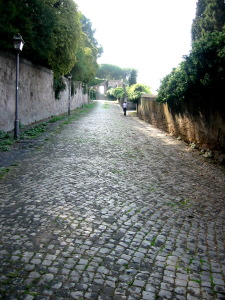 We walked up the hill,
startling a family of gypsys that had settled in the shrubbery to the
side, and soon reached the public garden, the Parco Savello, with its
fantastic views of the city. Beautiful day, beautiful weather,
beautiful views. Young lovers were entwined on stone benches, workers
on lunch break were enjoying the park, a young woman stopped to drink
from the fountain and used her hand to stop the flow of water which
then came out an opening near her mouth. It was the first time I had
seen that trick and it was one I used afterwards.
We walked up the hill,
startling a family of gypsys that had settled in the shrubbery to the
side, and soon reached the public garden, the Parco Savello, with its
fantastic views of the city. Beautiful day, beautiful weather,
beautiful views. Young lovers were entwined on stone benches, workers
on lunch break were enjoying the park, a young woman stopped to drink
from the fountain and used her hand to stop the flow of water which
then came out an opening near her mouth. It was the first time I had
seen that trick and it was one I used afterwards.
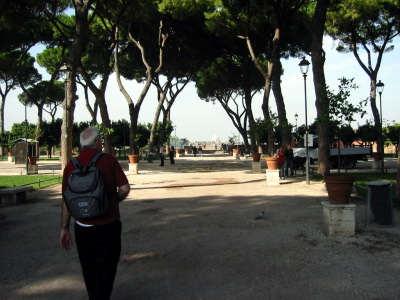
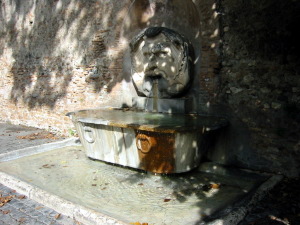 Rome is filled with fountains, all with good water and all
architecturally interesting, from the huge Trevi Fountain to the
humblest park fountain. One guide told us that Rome is a city of
ruins, fountains and obelisks. The obelisks were taken from Egypt when it
was under Roman rule.
Rome is filled with fountains, all with good water and all
architecturally interesting, from the huge Trevi Fountain to the
humblest park fountain. One guide told us that Rome is a city of
ruins, fountains and obelisks. The obelisks were taken from Egypt when it
was under Roman rule.
Near the park was the Priory of the Knights of Malta with its gate and
famous keyhole. We thought looking through the keyhole would be a
bust. My brother told me later that he thought at the time, "Why is he dragging me all the way up here to look through a keyhole?" As we approached a private car pulled up and disgorged two
pretty young women (Americans) and their guide, so we got in line
behind them to look through the keyhole. They oohed and ahhed and
told me they were having a great time. When I looked through the
keyhole I was stunned to discover that it was like magic as the Dome
of Saint Peter's appears to float in the air at the end of a garden
path lined with trees.
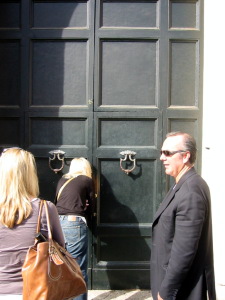
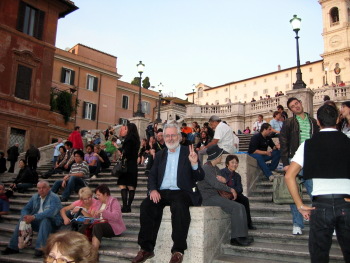 Late one afternoon we arrived at the bottom of the Spanish Steps and
relaxed for a bit watching the tourists and locals at the flower
stalls and around the ruined boat fountain, the Barcaccia. I had been
warned by several people about the plethora of beggars at the Spanish
Steps, but I saw little evidence of them. My brother and I climbed
the steps to the church at the top and looked back across the city at
the sunset, a golden-red delight.
Late one afternoon we arrived at the bottom of the Spanish Steps and
relaxed for a bit watching the tourists and locals at the flower
stalls and around the ruined boat fountain, the Barcaccia. I had been
warned by several people about the plethora of beggars at the Spanish
Steps, but I saw little evidence of them. My brother and I climbed
the steps to the church at the top and looked back across the city at
the sunset, a golden-red delight.  We walked back down and across the
city toward the Tiber looking for the Via della Scrofa and the famous
Alfredo alla Scrofa restaurant. There are two famous Alfredo
restaurants in Rome, each claiming to have the gold fork and spoon
presented to the original owner by Douglas Fairbanks and Mary
Pickford, but this is the older one. When we arrived the staff was still
dining together so we went next door for a coffee. After a time we
went back and managed to squeeze ourselves in without a reservation.
The food was fabulous. Not just the pasta, but everything, including
the house wine. The deserts were to die for. This was another
restaurant we visited again with Mary and Don.
We walked back down and across the
city toward the Tiber looking for the Via della Scrofa and the famous
Alfredo alla Scrofa restaurant. There are two famous Alfredo
restaurants in Rome, each claiming to have the gold fork and spoon
presented to the original owner by Douglas Fairbanks and Mary
Pickford, but this is the older one. When we arrived the staff was still
dining together so we went next door for a coffee. After a time we
went back and managed to squeeze ourselves in without a reservation.
The food was fabulous. Not just the pasta, but everything, including
the house wine. The deserts were to die for. This was another
restaurant we visited again with Mary and Don.
Near our hotel was Rome's only Gothic church, S. Maria Sopra Minerva. A
small Michaelangelo statue was next to the altar, but for me the best
attraction was Bernini's sculpture of a small elephant carrying an
obelisk on its back. Straight out of Disney, or actually vice-versa.
Rome offered many other sights and pleasures. For example, my brother
and I wandered up the modern Via Veneto with it's fancy shops and
restaurants, through the fortified Porta Pincians and into the
beautiful and serene Borgese Gardens.  We stayed there as long as we
could until a storm chased us out and down the via to my sister's
hotel and dinner. Another day we walked down the Via del Quirinale,
past the corner with the four fountains, and into the baroque church
Santa Maria della Vittoria in order to see Bernini's Cornaro Chapel
and his orgasmic Ecstasy of St. Teresa.
We stayed there as long as we
could until a storm chased us out and down the via to my sister's
hotel and dinner. Another day we walked down the Via del Quirinale,
past the corner with the four fountains, and into the baroque church
Santa Maria della Vittoria in order to see Bernini's Cornaro Chapel
and his orgasmic Ecstasy of St. Teresa. 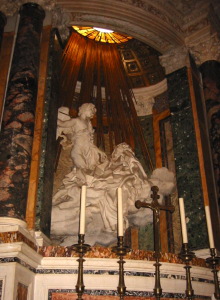 Then we elbowed our way through
a political gathering at the Piazza della Repubblica across from the
train station. One day we crossed the ancient Ponte Sisto and spent a few
hours exploring the working class Trastevere district with its
graffiti and litter. I don't think there are any 12.50 euro coffees
there!
Then we elbowed our way through
a political gathering at the Piazza della Repubblica across from the
train station. One day we crossed the ancient Ponte Sisto and spent a few
hours exploring the working class Trastevere district with its
graffiti and litter. I don't think there are any 12.50 euro coffees
there!
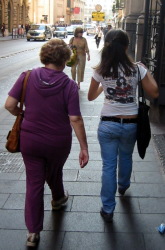 One thing that struck me in Rome was all the pairs of mothers and
daughters. They were shopping, walking, talking, drinking coffee,
just hanging out together. All in all I found Rome haunting and will
return when I can.
One thing that struck me in Rome was all the pairs of mothers and
daughters. They were shopping, walking, talking, drinking coffee,
just hanging out together. All in all I found Rome haunting and will
return when I can.
South to Sorrento
My sister and brother-in-law were off to Venice, but my brother and I
headed south. 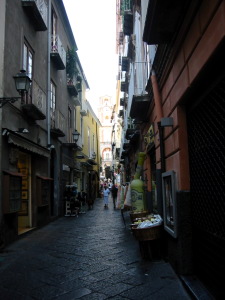 We traveled down to the coastal town of Sorrento and
stayed in an inexpensive but very nice room (with a balcony where I
managed to pen a letter home) on the street above the train
station. Sorrento has a wonderful old town with winding cobblestone
streets and lots of restaurants, shops, and other tourist
attractions. One night we happened on a very nice restaurant which was
packed with locals where my brother had the best pizza ever.
We traveled down to the coastal town of Sorrento and
stayed in an inexpensive but very nice room (with a balcony where I
managed to pen a letter home) on the street above the train
station. Sorrento has a wonderful old town with winding cobblestone
streets and lots of restaurants, shops, and other tourist
attractions. One night we happened on a very nice restaurant which was
packed with locals where my brother had the best pizza ever.
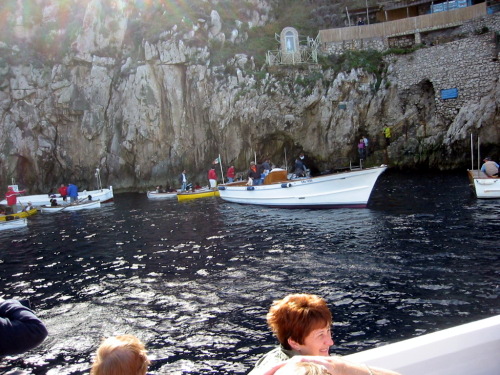 One day we took the boat out to Capri and wandered around this famous
pleasure island. First, of course, we took a small boat out to the
Grotta Azzurra, where we transferred into a little
rowboat, just my brother, myself and the singing oarsman. Then, after
waiting in a line of rowboats, the oarsman timed our entry with the
waves and pulled us (via a handy rope) while we lay flat in the boat,
into the Blue Grotto. If the tide's too high you can't get in and if
it's too low the entry is uneventful. We came at just the right time
as I wondered whether I should take off my glasses and thought my nose
might end up a bloody pulp. It was indeed brilliantly blue in the
grotto and our oarsman sang heartily as he rowed us around in circles
before reversing our steps and taking us back to the larger boat. I
thought, ``What a racket!''
One day we took the boat out to Capri and wandered around this famous
pleasure island. First, of course, we took a small boat out to the
Grotta Azzurra, where we transferred into a little
rowboat, just my brother, myself and the singing oarsman. Then, after
waiting in a line of rowboats, the oarsman timed our entry with the
waves and pulled us (via a handy rope) while we lay flat in the boat,
into the Blue Grotto. If the tide's too high you can't get in and if
it's too low the entry is uneventful. We came at just the right time
as I wondered whether I should take off my glasses and thought my nose
might end up a bloody pulp. It was indeed brilliantly blue in the
grotto and our oarsman sang heartily as he rowed us around in circles
before reversing our steps and taking us back to the larger boat. I
thought, ``What a racket!'' 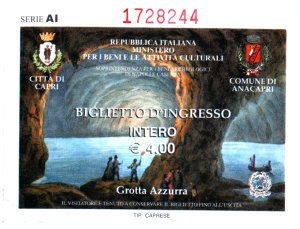 You not only have to pay for passage on the boat that brings you out, but when we first got into the rowboat we were
rowed bobbing up and down over to a government fee collector, looking
every bit an Italian gangster as he held court on a small dock. Our
oarsman assured us that he received nothing of this fee but hoped for
a tip from us on our return. He was already a bit upset because
usually they carry three or four people per rowboat, but my brother
and I were of such proportions that he could fit only the two of us.
But we tipped him very well at the end and he rowed away happy. So we
had to pay three times to see the Grotta Azzura, but I'm glad we did.
You not only have to pay for passage on the boat that brings you out, but when we first got into the rowboat we were
rowed bobbing up and down over to a government fee collector, looking
every bit an Italian gangster as he held court on a small dock. Our
oarsman assured us that he received nothing of this fee but hoped for
a tip from us on our return. He was already a bit upset because
usually they carry three or four people per rowboat, but my brother
and I were of such proportions that he could fit only the two of us.
But we tipped him very well at the end and he rowed away happy. So we
had to pay three times to see the Grotta Azzura, but I'm glad we did.
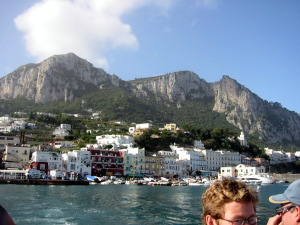
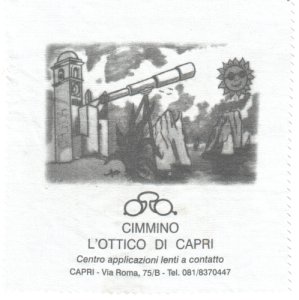 After, we rode the finicula up to the town and it's maze of narrow
winding streets, did some window shopping, and then took the footpath
off to Tiberius' Palace, known as Villa Jovis. We got wonderfully
lost, missed our turn and walked to the edge of the island. I had a
chance several times to ask directions in Italian and eventually we
found the right turn and took the long path up to Villa Jovis.
After, we rode the finicula up to the town and it's maze of narrow
winding streets, did some window shopping, and then took the footpath
off to Tiberius' Palace, known as Villa Jovis. We got wonderfully
lost, missed our turn and walked to the edge of the island. I had a
chance several times to ask directions in Italian and eventually we
found the right turn and took the long path up to Villa Jovis. 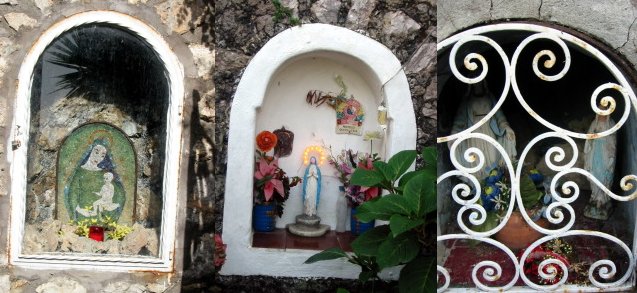 Along
the way I took pictures of a few of the many shrines to Mary that were in
alcoves of the walls of the houses along the path. After enumerable
steps, we eventually arrived at the Villa Jovis where we paid a fee, got
yelled at for going the wrong way, and wandered among the ruins.
Capri was a gorgeous place and I would have liked to explore the other
half of the island, away from tourist attractions.
Along
the way I took pictures of a few of the many shrines to Mary that were in
alcoves of the walls of the houses along the path. After enumerable
steps, we eventually arrived at the Villa Jovis where we paid a fee, got
yelled at for going the wrong way, and wandered among the ruins.
Capri was a gorgeous place and I would have liked to explore the other
half of the island, away from tourist attractions.
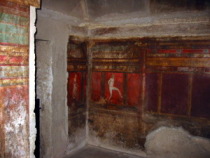 Then it was off to Pompeii. We took the earliest train from Sorrento
north. Our plan was to see Pompeii in the morning, go into Naples for
lunch, then climb Mount Vesuvius and, time permitting, visit
Herculaneum. Ha Ha!
Then it was off to Pompeii. We took the earliest train from Sorrento
north. Our plan was to see Pompeii in the morning, go into Naples for
lunch, then climb Mount Vesuvius and, time permitting, visit
Herculaneum. Ha Ha! 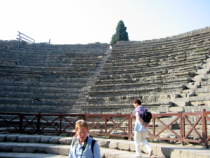 I don't know why we thought we could accomplish
all that, as it turned out Pompeii took all day and left us
exhausted. On the train travelling there we fell into conversation
with a pair of Philadelphia lawyers (a married couple) who had been
vacationing and were on their way to Rome and then home.
I don't know why we thought we could accomplish
all that, as it turned out Pompeii took all day and left us
exhausted. On the train travelling there we fell into conversation
with a pair of Philadelphia lawyers (a married couple) who had been
vacationing and were on their way to Rome and then home. 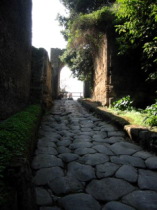 When we said we
were staying in Sorrento the woman exclaimed that we had to go to a
restaurant they had been to last Saturday. ``It's the best restaurant
in Italy!'' she claimed. And proceeded to tell us just how great the
food was and how great the view was and how great the ambiance was,
etc. So we filed that information away for our return to Sorrento.
When we said we
were staying in Sorrento the woman exclaimed that we had to go to a
restaurant they had been to last Saturday. ``It's the best restaurant
in Italy!'' she claimed. And proceeded to tell us just how great the
food was and how great the view was and how great the ambiance was,
etc. So we filed that information away for our return to Sorrento.
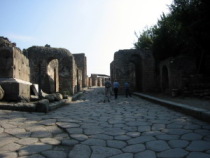 Pompeii was big, vast, and well preserved. So many things to see.
Walking down the wide streets past the houses made it very easy to
imagine life there. And the preserved, restored buildings included
everything you can imagine in a city: houses, shops, theaters, arenas,
guardhouses, temples, baths, government offices, granaries etc.
Pompeii was big, vast, and well preserved. So many things to see.
Walking down the wide streets past the houses made it very easy to
imagine life there. And the preserved, restored buildings included
everything you can imagine in a city: houses, shops, theaters, arenas,
guardhouses, temples, baths, government offices, granaries etc. 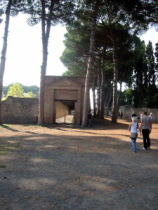 Quite
something, but very tiring with lots of walking. We walked through the city and out to the city walls (near the Villa of Mysteries which
has a well preserved fresco of a woman's marriage initiation rites).
We walked outside the walls for a time on a broad stone walkway,
then over to the Arena (small Coliseum) and gymnasium. I especially
enjoyed their two theaters, large and small.
Quite
something, but very tiring with lots of walking. We walked through the city and out to the city walls (near the Villa of Mysteries which
has a well preserved fresco of a woman's marriage initiation rites).
We walked outside the walls for a time on a broad stone walkway,
then over to the Arena (small Coliseum) and gymnasium. I especially
enjoyed their two theaters, large and small. 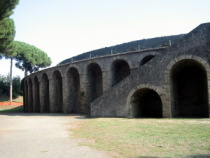 It was easy to imagine
myself watching a play there. 164 acres, 69 stops on the audio tour
and an all day affair. I'm so glad I went. I'll have to return some
time for those other sights I missed.
It was easy to imagine
myself watching a play there. 164 acres, 69 stops on the audio tour
and an all day affair. I'm so glad I went. I'll have to return some
time for those other sights I missed.
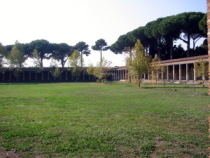
Back in Sorrento we determined to try out ``the best restaurant in
Italy'' that had been recommended to us by the Philadelphia lawyers. The restaurant turned out to be high in the hills above
Sorrento. When I asked the landlady's daughter how to get there she
asked why we wanted to go. I told her it was recommended to us but
she clearly thought we were crazy tourists. The only transport were
some infrequent buses or a taxi so we walked down to the train station
and hired Carlo and his taxi who assured us he knew right where it was. He didn't,
of course, but we finally got there where he volunteered to wait for
us in the parking lot. It was late October, tourist season was over,
and I think he knew he wouldn't see our like again for awhile. We
sent him home but took his phone number to call when we were done.
Of course, we were the only people in the restaurant. The food was
nothing to brag about, in fact, when they brought out the fish for us
to choose, one of them had a very cloudy eye. That's the one the Matre
D' (no other waiter in evidence) kept trying to get us to pick. We
didn't, of course. We got to talking with him a bit and found out that
last Saturday had been a wedding and the place had been packed and a
live band had played. He took us outside on the terrace to show us
the tremendous view we could have had last Saturday. So, poorer but
wiser we called Carlo and took our expensive trip back to Sorrento.
That night we both got diarrhea.
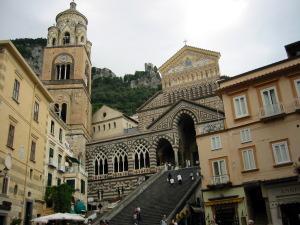 On our final day we toured down the Amalfi Coast. Spectacular sights:
the narrow winding road by the cliff, the houses clinging to the
hillside. At one point there was a flag woman stopping traffic because
the road was too narrow for two-way traffic. We ate at Amalfi at a
remote restaurant up several flights of stairs where we surprised the
staff who were watching soap operas on the TV. The food was authentic
and good. Unfortunately, the weather changed and cut short our
time. There's a walk I want to do next time that starts in Ravello
(Gore Vidal's Italian home) and descends several thousand feet on
ancient staircases to Amalfi.
On our final day we toured down the Amalfi Coast. Spectacular sights:
the narrow winding road by the cliff, the houses clinging to the
hillside. At one point there was a flag woman stopping traffic because
the road was too narrow for two-way traffic. We ate at Amalfi at a
remote restaurant up several flights of stairs where we surprised the
staff who were watching soap operas on the TV. The food was authentic
and good. Unfortunately, the weather changed and cut short our
time. There's a walk I want to do next time that starts in Ravello
(Gore Vidal's Italian home) and descends several thousand feet on
ancient staircases to Amalfi. 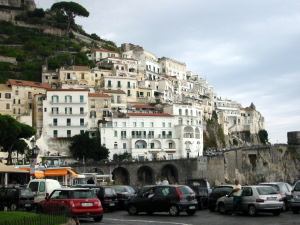
All too soon, with so much left undone, it was time to wend our way
home. I loved Italy and its people. I can't wait to go back.
 As Croatia is just a hop across the Adriatic from
Italy I booked a round trip flight from Rome to Dubrovnik not
realizing what a pain it would turn out to be. The flights were on
Croatia Airlines and, while the ticket claimed one stop, there were
actually two stops. First on entering Croatia (and last on leaving it)
the flight went through Split, in what was called a technical stop,
for Croation customs; then Zagreb, then Dubrovnik. At each stop we had to exit
the airplane and go back through security. On the way back it was
even worse as their computers were down so we not only had to get
re-screened by security each time, but also had to pick up and recheck
our bags.
As Croatia is just a hop across the Adriatic from
Italy I booked a round trip flight from Rome to Dubrovnik not
realizing what a pain it would turn out to be. The flights were on
Croatia Airlines and, while the ticket claimed one stop, there were
actually two stops. First on entering Croatia (and last on leaving it)
the flight went through Split, in what was called a technical stop,
for Croation customs; then Zagreb, then Dubrovnik. At each stop we had to exit
the airplane and go back through security. On the way back it was
even worse as their computers were down so we not only had to get
re-screened by security each time, but also had to pick up and recheck
our bags.
 The Croatian airports were charmingly small, straight out of the
1950s; boarding via stairs out on the tarmac. The security personnel
all wore very plain, light green Eastern European uniforms. The men
all had crew cuts. Men and women alike tended to be stern looking
blonds. Everything seemed spare, sparse and humorless. Funny thing
though, at one of these never-ending security screenings the alarms
went off when I went through the gateway. ``Oh!'' I said, ``I forgot
to take these coins out of my pocket,'' pulling coins out of my pocket
and showing the guard. ``OK, go ahead,'' said the guard and waved me
along without rechecking me. On the flights they served a
small traditional Croation pastry, the Pap Rentak, and offered to sell
me cartons of cigarettes.
The Croatian airports were charmingly small, straight out of the
1950s; boarding via stairs out on the tarmac. The security personnel
all wore very plain, light green Eastern European uniforms. The men
all had crew cuts. Men and women alike tended to be stern looking
blonds. Everything seemed spare, sparse and humorless. Funny thing
though, at one of these never-ending security screenings the alarms
went off when I went through the gateway. ``Oh!'' I said, ``I forgot
to take these coins out of my pocket,'' pulling coins out of my pocket
and showing the guard. ``OK, go ahead,'' said the guard and waved me
along without rechecking me. On the flights they served a
small traditional Croation pastry, the Pap Rentak, and offered to sell
me cartons of cigarettes.
 He had a very nice apartment with a grand view of the old walled city.
His fiance Kati and her sister Ewa had also come in from Berlin with
him. Lots of talk, talk, talk which I enjoyed very much. There is an
island just off the coast that can be plainly seen from Michael's
window. One morning I watched a huge cruise ship maneuver into
position, blocking a surprising amount of the view, and then
send wave after wave of boats full of tourists to the docks by the old
city. There must have been thousands of the tourists.
He had a very nice apartment with a grand view of the old walled city.
His fiance Kati and her sister Ewa had also come in from Berlin with
him. Lots of talk, talk, talk which I enjoyed very much. There is an
island just off the coast that can be plainly seen from Michael's
window. One morning I watched a huge cruise ship maneuver into
position, blocking a surprising amount of the view, and then
send wave after wave of boats full of tourists to the docks by the old
city. There must have been thousands of the tourists.
 That day we spent a lot of time in the old walled city, seeing the
sights and enjoying the feel of it. We ate outside at a friendly
restaurant off a winding stone stairway, and enjoyed fresh fish (which
the waitress carved into a dog's breakfast) and watched the tourists
stumble by. At dusk, after the tourists had gone back to their cruise
ship, we sat in Dubrovnik's nice main square and drank coffee while
families strolled by. A wedding party burst upon the scene loud and
laughing. The bride looked so happy.
That day we spent a lot of time in the old walled city, seeing the
sights and enjoying the feel of it. We ate outside at a friendly
restaurant off a winding stone stairway, and enjoyed fresh fish (which
the waitress carved into a dog's breakfast) and watched the tourists
stumble by. At dusk, after the tourists had gone back to their cruise
ship, we sat in Dubrovnik's nice main square and drank coffee while
families strolled by. A wedding party burst upon the scene loud and
laughing. The bride looked so happy.
 I took the train from the airport into Rome. I had read in the guidebooks that one should time-stamp one's train ticket at one of the machines on the platform. The guidebooks said that technically there was a fine for not doing so but it had never been known to be imposed on a tourist. In the compartment where I settled was an American family from South Carolina just arriving in Europe. I got to talking with the father and found out it was their first trip overseas. As the conductor made his way down the aisle towards us I showed him my ticket with the time-stamp upon it and asked if he had stamped his. This was all news to him. "Oh no," I said, shaking my head, "That's a hundred euro fine!" He began to panic at the thought that he'd made this mistake and that it was going to cost him. As the conductor got closer he began to ask others hurried questions, but received only Italian or broken English answers. When the conductor arrived he began explaining rapidly that he hadn't known about having to stamp his tickets, and began apologizing. The conductor looked at him like he was crazy and waved him off, punched his tickets and continued on down the aisle. He looked over at me to find me laughing. "You," he said, "are a very bad man."
I took the train from the airport into Rome. I had read in the guidebooks that one should time-stamp one's train ticket at one of the machines on the platform. The guidebooks said that technically there was a fine for not doing so but it had never been known to be imposed on a tourist. In the compartment where I settled was an American family from South Carolina just arriving in Europe. I got to talking with the father and found out it was their first trip overseas. As the conductor made his way down the aisle towards us I showed him my ticket with the time-stamp upon it and asked if he had stamped his. This was all news to him. "Oh no," I said, shaking my head, "That's a hundred euro fine!" He began to panic at the thought that he'd made this mistake and that it was going to cost him. As the conductor got closer he began to ask others hurried questions, but received only Italian or broken English answers. When the conductor arrived he began explaining rapidly that he hadn't known about having to stamp his tickets, and began apologizing. The conductor looked at him like he was crazy and waved him off, punched his tickets and continued on down the aisle. He looked over at me to find me laughing. "You," he said, "are a very bad man."
 Alright, so off we went. The Mimosa hotel was located on Via di Santa
Chiara a few blocks from the Pantheon. My cabbie didn't know where it
was, of course, but he did drop me off on the right street, if a few blocks away at another
hotel. At least he got me to the street. Comparing notes with my
brother later, he had the same thing happen to him at the airport
except he was taken for even more euros. Experience taught us that taxis in
Rome are extraordinarily reasonable and a cab ride from the train station to
the hotel should have cost us less than 10 euros. Ah, live and learn.
And his taxi driver didn't even take him to the street but dropped him
off at Corseo Vittorio Emanuelle, the large boulevard some blocks
away.
Alright, so off we went. The Mimosa hotel was located on Via di Santa
Chiara a few blocks from the Pantheon. My cabbie didn't know where it
was, of course, but he did drop me off on the right street, if a few blocks away at another
hotel. At least he got me to the street. Comparing notes with my
brother later, he had the same thing happen to him at the airport
except he was taken for even more euros. Experience taught us that taxis in
Rome are extraordinarily reasonable and a cab ride from the train station to
the hotel should have cost us less than 10 euros. Ah, live and learn.
And his taxi driver didn't even take him to the street but dropped him
off at Corseo Vittorio Emanuelle, the large boulevard some blocks
away.
 At the wrong hotel, where I was dropped off, I wandered up and down
the street for a few minutes and then entered the lobby and---trying
out my smattering of Italian---asked where the Hotel Mimosa was. The
hotel clerk took me outside and, while pointing up the street,
unleashed a stream of incomprehensible Italian. I had to confess, in
my memorized Italian phrases, that I didn't speak Italian very well.
``English?'' he asked and then told me where the hotel was.
At the wrong hotel, where I was dropped off, I wandered up and down
the street for a few minutes and then entered the lobby and---trying
out my smattering of Italian---asked where the Hotel Mimosa was. The
hotel clerk took me outside and, while pointing up the street,
unleashed a stream of incomprehensible Italian. I had to confess, in
my memorized Italian phrases, that I didn't speak Italian very well.
``English?'' he asked and then told me where the hotel was.
 After we ordered, the waiter said, ``And some bruschetti.'' No, I
said, we don't want any. But he brought it anyway and it was the best
bruschetti I have ever had. Delicious. Ever since then I've been
trying bruschetti to find any as good. No luck yet. Don ordered only
a drink, a Dram Bowie on the rocks. The waiter said, ``Don't you want
a man's drink, instead?'' Don declined.
After we ordered, the waiter said, ``And some bruschetti.'' No, I
said, we don't want any. But he brought it anyway and it was the best
bruschetti I have ever had. Delicious. Ever since then I've been
trying bruschetti to find any as good. No luck yet. Don ordered only
a drink, a Dram Bowie on the rocks. The waiter said, ``Don't you want
a man's drink, instead?'' Don declined.
 The Pantheon itself sits erect, brooding over the piazza. I found
it's interior uninspiring, but its simple exterior was quite
effective. From the Pantheon we walked by the house of parliament
building (where there was a changing scene every time, including protestors and TV cameras from time to
time) and by the column of Marcus Aurelius to the Trevi Fountain. This was the
first time I saw the famous fountain, which was lit up beautifully with crowds of people
around and vendors working them. The water sounded soothingly and the
crowd was happily chattering away. I threw a coin in the fountain in
the modern ritual making a wish to visit again with my true love.
The Pantheon itself sits erect, brooding over the piazza. I found
it's interior uninspiring, but its simple exterior was quite
effective. From the Pantheon we walked by the house of parliament
building (where there was a changing scene every time, including protestors and TV cameras from time to
time) and by the column of Marcus Aurelius to the Trevi Fountain. This was the
first time I saw the famous fountain, which was lit up beautifully with crowds of people
around and vendors working them. The water sounded soothingly and the
crowd was happily chattering away. I threw a coin in the fountain in
the modern ritual making a wish to visit again with my true love.

 Next day we joined up with Mary and Don (taking our usual
Pantheon-Parliament-Aurelius-Trevi route) for some sightseeing. Mary
is not the most mobile tourist and so we took a few bus tours. At St.
Paul's I stopped to give a gypsy with child a few coins. I asked how
she was doing (in Italian) and she responded, ``Mal.'' ``Bad?'' I
said, ``how can that be, the sun is out and you have a beautiful
baby.'' They may have been renting the children, but it became such a
habit for me that Paul made me turn around in Sorrento once telling me
I had passed a begging mother and child without giving them anything.
One nursing mother even pursued me through the train station wanting more.
Next day we joined up with Mary and Don (taking our usual
Pantheon-Parliament-Aurelius-Trevi route) for some sightseeing. Mary
is not the most mobile tourist and so we took a few bus tours. At St.
Paul's I stopped to give a gypsy with child a few coins. I asked how
she was doing (in Italian) and she responded, ``Mal.'' ``Bad?'' I
said, ``how can that be, the sun is out and you have a beautiful
baby.'' They may have been renting the children, but it became such a
habit for me that Paul made me turn around in Sorrento once telling me
I had passed a begging mother and child without giving them anything.
One nursing mother even pursued me through the train station wanting more.

 At one point, much to Mary's chagrin, our tour bus broke down outside
the Piazza Navone and we walked by foot over the Tiber across the
Ponte Sant'Angelo with its Bernini angels, past the looming papal
fortress, the Castel Sant' Angelo, and into the Vatican. We walked
past a long row of vendors selling souvenirs, trinkets, jewelry,
books, clothes, etc. The Vatican itself is as ostentatious as
advertised. As a fallen away Catholic I'm sure I'm prejudiced, but I
found St. Peter's to be much too big and many artworks there, notably The
Pieta, were too far away to enjoy. The Vatican museums were quite an
exhibition of treasures (``gallery upon gallery''), but I couldn't
help thinking about the poor. For example, there were room after room
of ornate gilded cabinets whose sole purpose was to hold the gifts
given to the popes over the centuries. We made a tourist mistake of
falling for a pitch and engaging a guide for a few euros. I suppose
it's because we are soft hearted. He was a sweet old man, dressed in
faux professor garb, but his exposition consisted of things he'd
learned by rote that could be found in any ordinary guidebook. (He
also made the unforgivable error of recommending to us a restaurant
run by a friend of his which turned out to serve terrible Americanized
food [beef and potatoes] and vinegary wine.) The Sistene Chapel was
quite charming, however, and well worth the time spent there. I was
glad to see the Delphic Sybil among the ceiling's images.
At one point, much to Mary's chagrin, our tour bus broke down outside
the Piazza Navone and we walked by foot over the Tiber across the
Ponte Sant'Angelo with its Bernini angels, past the looming papal
fortress, the Castel Sant' Angelo, and into the Vatican. We walked
past a long row of vendors selling souvenirs, trinkets, jewelry,
books, clothes, etc. The Vatican itself is as ostentatious as
advertised. As a fallen away Catholic I'm sure I'm prejudiced, but I
found St. Peter's to be much too big and many artworks there, notably The
Pieta, were too far away to enjoy. The Vatican museums were quite an
exhibition of treasures (``gallery upon gallery''), but I couldn't
help thinking about the poor. For example, there were room after room
of ornate gilded cabinets whose sole purpose was to hold the gifts
given to the popes over the centuries. We made a tourist mistake of
falling for a pitch and engaging a guide for a few euros. I suppose
it's because we are soft hearted. He was a sweet old man, dressed in
faux professor garb, but his exposition consisted of things he'd
learned by rote that could be found in any ordinary guidebook. (He
also made the unforgivable error of recommending to us a restaurant
run by a friend of his which turned out to serve terrible Americanized
food [beef and potatoes] and vinegary wine.) The Sistene Chapel was
quite charming, however, and well worth the time spent there. I was
glad to see the Delphic Sybil among the ceiling's images.
 From the Capitoline hill we went exploring the Forum. The Senate
House was much more modest than I expected, a long rectangular
building with several low tiers on each side. Truth is, I found it
hard to make sense of all the bits and pieces of ruin that were
sticking up here and there in the Forum.
From the Capitoline hill we went exploring the Forum. The Senate
House was much more modest than I expected, a long rectangular
building with several low tiers on each side. Truth is, I found it
hard to make sense of all the bits and pieces of ruin that were
sticking up here and there in the Forum.  I took their audio tour, but
remember almost nothing. From the Forum we went up the Palantine hill
and had a look at the high-rent district of ancient Rome, that is, the
imperial housing. There was a partially restored villa that was
interesting to see, but what I remember most was the greenery, the
gardens, the light breeze, the dappled sun. It all seemed very
pleasant.
I took their audio tour, but
remember almost nothing. From the Forum we went up the Palantine hill
and had a look at the high-rent district of ancient Rome, that is, the
imperial housing. There was a partially restored villa that was
interesting to see, but what I remember most was the greenery, the
gardens, the light breeze, the dappled sun. It all seemed very
pleasant.

 We walked through
the park and asked directions from a bus driver. The driver spoke only
Italian and I failed to make a meaningful connection. He had an
interesting zig-zag kind of hand motion though and undoubtedly that's
the way we should have gone. We didn't though, walking back through
the park to Via Nicola Salvi and the up a very inviting drive called
Via Della Domus Aurea. This turned out to be a family park with
benches along the drive and a small piazza with the ever present Roman
fountain at the end. In the park was a great family scene, from the
oldest grandparents walking with canes and assistance to the youngest
babies. The boys were chasing each other with sticks and the
girls were playing hopscotch on chalked outlines. As we sat on a bench
and rested I received a disapproving look from a Roman matron, as if
we tourists were invading their private space.
We walked through
the park and asked directions from a bus driver. The driver spoke only
Italian and I failed to make a meaningful connection. He had an
interesting zig-zag kind of hand motion though and undoubtedly that's
the way we should have gone. We didn't though, walking back through
the park to Via Nicola Salvi and the up a very inviting drive called
Via Della Domus Aurea. This turned out to be a family park with
benches along the drive and a small piazza with the ever present Roman
fountain at the end. In the park was a great family scene, from the
oldest grandparents walking with canes and assistance to the youngest
babies. The boys were chasing each other with sticks and the
girls were playing hopscotch on chalked outlines. As we sat on a bench
and rested I received a disapproving look from a Roman matron, as if
we tourists were invading their private space.
 From here it was a short walk to the heart of the Ghetto
with its many shops and curiosities. I thought it would be pleasant
to have a bookshop there. At the end of the main street are the remains
of the huge portico built by Augustus for his sister Octavia. Most of
it is long gone and what remains has some unattractive medieval
construction. For centuries it was the main fish market in Rome.
From here it was a short walk to the heart of the Ghetto
with its many shops and curiosities. I thought it would be pleasant
to have a bookshop there. At the end of the main street are the remains
of the huge portico built by Augustus for his sister Octavia. Most of
it is long gone and what remains has some unattractive medieval
construction. For centuries it was the main fish market in Rome.
 We were looking to enjoy a repast at Piperno's, one of the oldest
restaurants in Rome. It had been known as Father Abrahams or more
commonly, Pappa Abrams. Its specialty was Jewish artichokes. It was
in a small piazza fed by a one-way alley with another leading
away. The food was very good, and the waiters better. Jewish
artichokes are roasted and so have some charring at their edges. Paul
had left some of the outer leaves but the waiter told him to eat them
up, that they were good for him. I'm not the neatest of eaters and
after one course had left crumbs on the table. The waiter
solemnly and meticulously scraped these crumbs off the table with a
stiff card. It was all my brother and I could do to not laugh out
loud.
We were looking to enjoy a repast at Piperno's, one of the oldest
restaurants in Rome. It had been known as Father Abrahams or more
commonly, Pappa Abrams. Its specialty was Jewish artichokes. It was
in a small piazza fed by a one-way alley with another leading
away. The food was very good, and the waiters better. Jewish
artichokes are roasted and so have some charring at their edges. Paul
had left some of the outer leaves but the waiter told him to eat them
up, that they were good for him. I'm not the neatest of eaters and
after one course had left crumbs on the table. The waiter
solemnly and meticulously scraped these crumbs off the table with a
stiff card. It was all my brother and I could do to not laugh out
loud.  It was such fun that we brought my sister and brother-in-law by
for dinner one night. That night our taxicab driver started cursing
as he could not figure out how to maneuver through the alleys to
deliver us to the front door and had to let us off at the wrong end of a
one way alley and let us walk.
It was such fun that we brought my sister and brother-in-law by
for dinner one night. That night our taxicab driver started cursing
as he could not figure out how to maneuver through the alleys to
deliver us to the front door and had to let us off at the wrong end of a
one way alley and let us walk.
 We had to pay a visit of course to
the nearby medieval church of S. Maria in Cosmedin where lives the Boca della
Verite (The Mouth of Truth) which figured so in the film Roman Holiday. And then we went in search of another mouth and ventured out
on the Ponte Palatino to get a view of the Cloaca Maxima, the mouth of
Rome's ancient sewer, where the waste of the ancient rich had emptied into the
Tiber.
We had to pay a visit of course to
the nearby medieval church of S. Maria in Cosmedin where lives the Boca della
Verite (The Mouth of Truth) which figured so in the film Roman Holiday. And then we went in search of another mouth and ventured out
on the Ponte Palatino to get a view of the Cloaca Maxima, the mouth of
Rome's ancient sewer, where the waste of the ancient rich had emptied into the
Tiber.
 We walked up the hill,
startling a family of gypsys that had settled in the shrubbery to the
side, and soon reached the public garden, the Parco Savello, with its
fantastic views of the city. Beautiful day, beautiful weather,
beautiful views. Young lovers were entwined on stone benches, workers
on lunch break were enjoying the park, a young woman stopped to drink
from the fountain and used her hand to stop the flow of water which
then came out an opening near her mouth. It was the first time I had
seen that trick and it was one I used afterwards.
We walked up the hill,
startling a family of gypsys that had settled in the shrubbery to the
side, and soon reached the public garden, the Parco Savello, with its
fantastic views of the city. Beautiful day, beautiful weather,
beautiful views. Young lovers were entwined on stone benches, workers
on lunch break were enjoying the park, a young woman stopped to drink
from the fountain and used her hand to stop the flow of water which
then came out an opening near her mouth. It was the first time I had
seen that trick and it was one I used afterwards.

 Rome is filled with fountains, all with good water and all
architecturally interesting, from the huge Trevi Fountain to the
humblest park fountain. One guide told us that Rome is a city of
ruins, fountains and obelisks. The obelisks were taken from Egypt when it
was under Roman rule.
Rome is filled with fountains, all with good water and all
architecturally interesting, from the huge Trevi Fountain to the
humblest park fountain. One guide told us that Rome is a city of
ruins, fountains and obelisks. The obelisks were taken from Egypt when it
was under Roman rule.

 Late one afternoon we arrived at the bottom of the Spanish Steps and
relaxed for a bit watching the tourists and locals at the flower
stalls and around the ruined boat fountain, the Barcaccia. I had been
warned by several people about the plethora of beggars at the Spanish
Steps, but I saw little evidence of them. My brother and I climbed
the steps to the church at the top and looked back across the city at
the sunset, a golden-red delight.
Late one afternoon we arrived at the bottom of the Spanish Steps and
relaxed for a bit watching the tourists and locals at the flower
stalls and around the ruined boat fountain, the Barcaccia. I had been
warned by several people about the plethora of beggars at the Spanish
Steps, but I saw little evidence of them. My brother and I climbed
the steps to the church at the top and looked back across the city at
the sunset, a golden-red delight.  We walked back down and across the
city toward the Tiber looking for the Via della Scrofa and the famous
Alfredo alla Scrofa restaurant. There are two famous Alfredo
restaurants in Rome, each claiming to have the gold fork and spoon
presented to the original owner by Douglas Fairbanks and Mary
Pickford, but this is the older one. When we arrived the staff was still
dining together so we went next door for a coffee. After a time we
went back and managed to squeeze ourselves in without a reservation.
The food was fabulous. Not just the pasta, but everything, including
the house wine. The deserts were to die for. This was another
restaurant we visited again with Mary and Don.
We walked back down and across the
city toward the Tiber looking for the Via della Scrofa and the famous
Alfredo alla Scrofa restaurant. There are two famous Alfredo
restaurants in Rome, each claiming to have the gold fork and spoon
presented to the original owner by Douglas Fairbanks and Mary
Pickford, but this is the older one. When we arrived the staff was still
dining together so we went next door for a coffee. After a time we
went back and managed to squeeze ourselves in without a reservation.
The food was fabulous. Not just the pasta, but everything, including
the house wine. The deserts were to die for. This was another
restaurant we visited again with Mary and Don.
 We stayed there as long as we
could until a storm chased us out and down the via to my sister's
hotel and dinner. Another day we walked down the Via del Quirinale,
past the corner with the four fountains, and into the baroque church
Santa Maria della Vittoria in order to see Bernini's Cornaro Chapel
and his orgasmic Ecstasy of St. Teresa.
We stayed there as long as we
could until a storm chased us out and down the via to my sister's
hotel and dinner. Another day we walked down the Via del Quirinale,
past the corner with the four fountains, and into the baroque church
Santa Maria della Vittoria in order to see Bernini's Cornaro Chapel
and his orgasmic Ecstasy of St. Teresa.  Then we elbowed our way through
a political gathering at the Piazza della Repubblica across from the
train station. One day we crossed the ancient Ponte Sisto and spent a few
hours exploring the working class Trastevere district with its
graffiti and litter. I don't think there are any 12.50 euro coffees
there!
Then we elbowed our way through
a political gathering at the Piazza della Repubblica across from the
train station. One day we crossed the ancient Ponte Sisto and spent a few
hours exploring the working class Trastevere district with its
graffiti and litter. I don't think there are any 12.50 euro coffees
there!
 One thing that struck me in Rome was all the pairs of mothers and
daughters. They were shopping, walking, talking, drinking coffee,
just hanging out together. All in all I found Rome haunting and will
return when I can.
One thing that struck me in Rome was all the pairs of mothers and
daughters. They were shopping, walking, talking, drinking coffee,
just hanging out together. All in all I found Rome haunting and will
return when I can.
 We traveled down to the coastal town of Sorrento and
stayed in an inexpensive but very nice room (with a balcony where I
managed to pen a letter home) on the street above the train
station. Sorrento has a wonderful old town with winding cobblestone
streets and lots of restaurants, shops, and other tourist
attractions. One night we happened on a very nice restaurant which was
packed with locals where my brother had the best pizza ever.
We traveled down to the coastal town of Sorrento and
stayed in an inexpensive but very nice room (with a balcony where I
managed to pen a letter home) on the street above the train
station. Sorrento has a wonderful old town with winding cobblestone
streets and lots of restaurants, shops, and other tourist
attractions. One night we happened on a very nice restaurant which was
packed with locals where my brother had the best pizza ever.
 One day we took the boat out to Capri and wandered around this famous
pleasure island. First, of course, we took a small boat out to the
Grotta Azzurra, where we transferred into a little
rowboat, just my brother, myself and the singing oarsman. Then, after
waiting in a line of rowboats, the oarsman timed our entry with the
waves and pulled us (via a handy rope) while we lay flat in the boat,
into the Blue Grotto. If the tide's too high you can't get in and if
it's too low the entry is uneventful. We came at just the right time
as I wondered whether I should take off my glasses and thought my nose
might end up a bloody pulp. It was indeed brilliantly blue in the
grotto and our oarsman sang heartily as he rowed us around in circles
before reversing our steps and taking us back to the larger boat. I
thought, ``What a racket!''
One day we took the boat out to Capri and wandered around this famous
pleasure island. First, of course, we took a small boat out to the
Grotta Azzurra, where we transferred into a little
rowboat, just my brother, myself and the singing oarsman. Then, after
waiting in a line of rowboats, the oarsman timed our entry with the
waves and pulled us (via a handy rope) while we lay flat in the boat,
into the Blue Grotto. If the tide's too high you can't get in and if
it's too low the entry is uneventful. We came at just the right time
as I wondered whether I should take off my glasses and thought my nose
might end up a bloody pulp. It was indeed brilliantly blue in the
grotto and our oarsman sang heartily as he rowed us around in circles
before reversing our steps and taking us back to the larger boat. I
thought, ``What a racket!''  You not only have to pay for passage on the boat that brings you out, but when we first got into the rowboat we were
rowed bobbing up and down over to a government fee collector, looking
every bit an Italian gangster as he held court on a small dock. Our
oarsman assured us that he received nothing of this fee but hoped for
a tip from us on our return. He was already a bit upset because
usually they carry three or four people per rowboat, but my brother
and I were of such proportions that he could fit only the two of us.
But we tipped him very well at the end and he rowed away happy. So we
had to pay three times to see the Grotta Azzura, but I'm glad we did.
You not only have to pay for passage on the boat that brings you out, but when we first got into the rowboat we were
rowed bobbing up and down over to a government fee collector, looking
every bit an Italian gangster as he held court on a small dock. Our
oarsman assured us that he received nothing of this fee but hoped for
a tip from us on our return. He was already a bit upset because
usually they carry three or four people per rowboat, but my brother
and I were of such proportions that he could fit only the two of us.
But we tipped him very well at the end and he rowed away happy. So we
had to pay three times to see the Grotta Azzura, but I'm glad we did.

 After, we rode the finicula up to the town and it's maze of narrow
winding streets, did some window shopping, and then took the footpath
off to Tiberius' Palace, known as Villa Jovis. We got wonderfully
lost, missed our turn and walked to the edge of the island. I had a
chance several times to ask directions in Italian and eventually we
found the right turn and took the long path up to Villa Jovis.
After, we rode the finicula up to the town and it's maze of narrow
winding streets, did some window shopping, and then took the footpath
off to Tiberius' Palace, known as Villa Jovis. We got wonderfully
lost, missed our turn and walked to the edge of the island. I had a
chance several times to ask directions in Italian and eventually we
found the right turn and took the long path up to Villa Jovis.  Along
the way I took pictures of a few of the many shrines to Mary that were in
alcoves of the walls of the houses along the path. After enumerable
steps, we eventually arrived at the Villa Jovis where we paid a fee, got
yelled at for going the wrong way, and wandered among the ruins.
Capri was a gorgeous place and I would have liked to explore the other
half of the island, away from tourist attractions.
Along
the way I took pictures of a few of the many shrines to Mary that were in
alcoves of the walls of the houses along the path. After enumerable
steps, we eventually arrived at the Villa Jovis where we paid a fee, got
yelled at for going the wrong way, and wandered among the ruins.
Capri was a gorgeous place and I would have liked to explore the other
half of the island, away from tourist attractions.
 Then it was off to Pompeii. We took the earliest train from Sorrento
north. Our plan was to see Pompeii in the morning, go into Naples for
lunch, then climb Mount Vesuvius and, time permitting, visit
Herculaneum. Ha Ha!
Then it was off to Pompeii. We took the earliest train from Sorrento
north. Our plan was to see Pompeii in the morning, go into Naples for
lunch, then climb Mount Vesuvius and, time permitting, visit
Herculaneum. Ha Ha!  I don't know why we thought we could accomplish
all that, as it turned out Pompeii took all day and left us
exhausted. On the train travelling there we fell into conversation
with a pair of Philadelphia lawyers (a married couple) who had been
vacationing and were on their way to Rome and then home.
I don't know why we thought we could accomplish
all that, as it turned out Pompeii took all day and left us
exhausted. On the train travelling there we fell into conversation
with a pair of Philadelphia lawyers (a married couple) who had been
vacationing and were on their way to Rome and then home.  When we said we
were staying in Sorrento the woman exclaimed that we had to go to a
restaurant they had been to last Saturday. ``It's the best restaurant
in Italy!'' she claimed. And proceeded to tell us just how great the
food was and how great the view was and how great the ambiance was,
etc. So we filed that information away for our return to Sorrento.
When we said we
were staying in Sorrento the woman exclaimed that we had to go to a
restaurant they had been to last Saturday. ``It's the best restaurant
in Italy!'' she claimed. And proceeded to tell us just how great the
food was and how great the view was and how great the ambiance was,
etc. So we filed that information away for our return to Sorrento.
 Pompeii was big, vast, and well preserved. So many things to see.
Walking down the wide streets past the houses made it very easy to
imagine life there. And the preserved, restored buildings included
everything you can imagine in a city: houses, shops, theaters, arenas,
guardhouses, temples, baths, government offices, granaries etc.
Pompeii was big, vast, and well preserved. So many things to see.
Walking down the wide streets past the houses made it very easy to
imagine life there. And the preserved, restored buildings included
everything you can imagine in a city: houses, shops, theaters, arenas,
guardhouses, temples, baths, government offices, granaries etc.  Quite
something, but very tiring with lots of walking. We walked through the city and out to the city walls (near the Villa of Mysteries which
has a well preserved fresco of a woman's marriage initiation rites).
We walked outside the walls for a time on a broad stone walkway,
then over to the Arena (small Coliseum) and gymnasium. I especially
enjoyed their two theaters, large and small.
Quite
something, but very tiring with lots of walking. We walked through the city and out to the city walls (near the Villa of Mysteries which
has a well preserved fresco of a woman's marriage initiation rites).
We walked outside the walls for a time on a broad stone walkway,
then over to the Arena (small Coliseum) and gymnasium. I especially
enjoyed their two theaters, large and small.  It was easy to imagine
myself watching a play there. 164 acres, 69 stops on the audio tour
and an all day affair. I'm so glad I went. I'll have to return some
time for those other sights I missed.
It was easy to imagine
myself watching a play there. 164 acres, 69 stops on the audio tour
and an all day affair. I'm so glad I went. I'll have to return some
time for those other sights I missed.

 On our final day we toured down the Amalfi Coast. Spectacular sights:
the narrow winding road by the cliff, the houses clinging to the
hillside. At one point there was a flag woman stopping traffic because
the road was too narrow for two-way traffic. We ate at Amalfi at a
remote restaurant up several flights of stairs where we surprised the
staff who were watching soap operas on the TV. The food was authentic
and good. Unfortunately, the weather changed and cut short our
time. There's a walk I want to do next time that starts in Ravello
(Gore Vidal's Italian home) and descends several thousand feet on
ancient staircases to Amalfi.
On our final day we toured down the Amalfi Coast. Spectacular sights:
the narrow winding road by the cliff, the houses clinging to the
hillside. At one point there was a flag woman stopping traffic because
the road was too narrow for two-way traffic. We ate at Amalfi at a
remote restaurant up several flights of stairs where we surprised the
staff who were watching soap operas on the TV. The food was authentic
and good. Unfortunately, the weather changed and cut short our
time. There's a walk I want to do next time that starts in Ravello
(Gore Vidal's Italian home) and descends several thousand feet on
ancient staircases to Amalfi. 